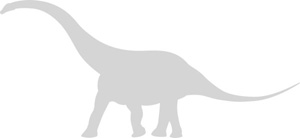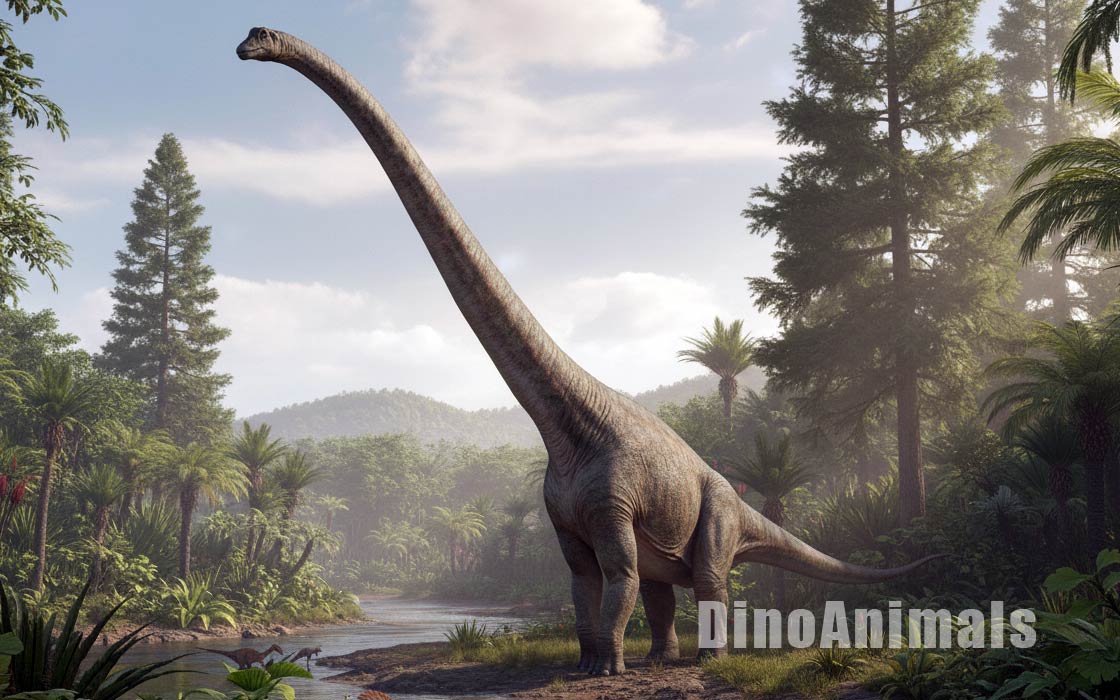Every month, 100,000 readers use the Dinosaur Database, but we receive no support from you. Developing and updating the database requires a lot of work. If you want it to remain open and be updated, please support us via the "Buy us a coffee" button available on every page or via the Support page.
Dinosaur: Sauroposeidon proteles

| Length*: | 29 m | 95.1 ft |
| Weight*: | 48 t | 105,822 lb |
*The largest known specimen
Period
Epoch: Early Cretaceous
Stage: Aptian-Albian
Years: 115-108 Ma
Details
Status: valid
Author: Wedel, Cifelli & Sanders
Year: 2000
Distribution
Area: North America
Country: USA
Region: Oklahoma, Texas, Wyoming, Montana
Formation: Antlers, Twin Mountains, Cloverly
Description
Sauroposeidon proteles
Sauroposeidon proteles is one of the tallest known sauropods, discovered in the Early Cretaceous period, around 115-108 million years ago (Aptian-Albian stage). The fossils were found in the Antlers Formation of Oklahoma, USA. Sauroposeidon is known for its enormous neck, which likely made it one of the tallest animals to ever walk the Earth. The genus name Sauroposeidon translates to “lizard earthquake god,” emphasizing its colossal size, while the species name proteles means “perfected before the end,” referring to its advanced evolutionary features as one of the last giant sauropods.
Physical Characteristics
Sauroposeidon proteles is estimated to have been around 27-29 meters (~88-95 ft) in length and to have weighed around 40-48 metric tons. Its most remarkable feature is its neck, which was approximately 11–12 meters (36–39 feet) long, allowing the dinosaur to browse the tops of trees at heights no other animal could reach. Based on fossil evidence, including four cervical vertebrae, the neck was composed of elongated, highly pneumatic (air-filled) vertebrae, making it relatively lightweight for its size.
Each cervical vertebra measured over 1.2 meters (4 feet) in length, with deep pleurocoels (air sacs) that helped reduce the weight of the neck while maintaining strength. This pneumatic adaptation, common among sauropods, was critical for supporting such a long neck without overburdening the animal’s skeleton. The limbs of Sauroposeidon were columnar, like other sauropods, supporting its massive body. The tail was long and muscular, providing balance and counterweight to the massive neck.
The head of Sauroposeidon was relatively small compared to its body, with peg-like teeth suited for stripping leaves from trees. The skull itself is poorly known, but it likely resembled that of other closely related sauropods, such as Brachiosaurus and Giraffatitan, with a high placement of the nostrils and large, forward-facing eyes.
Diet and Feeding Habits
Sauroposeidon proteles was a herbivorous dinosaur, feeding primarily on conifers, cycads, and other high-growing plants that were abundant during the Early Cretaceous. Its enormous neck allowed it to reach vegetation as high as 18 meters (59 feet) off the ground, well beyond the reach of any other herbivores in its ecosystem.
The peg-like teeth of Sauroposeidon were not adapted for chewing; instead, it likely stripped foliage from branches and swallowed it whole. The food would then have been processed in its massive digestive system, which used fermentation to break down tough plant material. The dinosaur’s long neck enabled it to browse from a wide area without needing to move its massive body frequently, making feeding more efficient.
Habitat and Distribution
The fossils of Sauroposeidon proteles were discovered in the Antlers Formation, which represents an Early Cretaceous coastal floodplain environment in what is now Oklahoma. This region was characterized by river systems, forests, and open floodplains, with abundant plant life to support large herbivores like Sauroposeidon. The climate during this time was warm and humid, with seasonal variations that contributed to a diverse ecosystem of flora and fauna.
The Antlers Formation has yielded a variety of dinosaur fossils, including other large sauropods, theropods like Acrocanthosaurus, and smaller herbivorous dinosaurs. Sauroposeidon likely moved through forested areas, feeding on the tallest trees and leaving the lower vegetation for smaller herbivores. Its ability to reach such high vegetation would have minimized competition with other large herbivores, allowing it to occupy a unique ecological niche.
Behavior and Social Structure
While direct evidence of social behavior in Sauroposeidon proteles is limited, many sauropods are thought to have lived in herds for protection and to enhance foraging efficiency. Herding behavior would have been beneficial for protecting juveniles from large predators, such as Acrocanthosaurus, which also lived in the same region.
Given its enormous size, adult Sauroposeidon would have had few natural predators, but juveniles may have been more vulnerable. Herds may have moved together in search of food, and their long necks would have allowed them to spread out while still foraging from the same area. The dinosaur’s tail may have also been used as a defensive weapon, swinging it at predators to deter attacks.
Discovery and Research
The fossils of Sauroposeidon proteles were first discovered in 1994 in southeastern Oklahoma by Dr. Richard Cifelli and his team. Initially, the large vertebrae were mistaken for petrified tree trunks due to their massive size. After careful study, it became clear that the bones belonged to a previously unknown giant sauropod. The formal description of Sauroposeidon was published in 2000.
The holotype consists of four massive cervical vertebrae, providing valuable insights into the neck structure of the animal. Since its discovery, Sauroposeidon has been the subject of continued research, focusing on its size, evolutionary relationships, and adaptations for such an enormous neck. Paleontologists have compared it to other well-known sauropods, such as Brachiosaurus and Giraffatitan, to better understand its place within the Sauropoda clade, specifically within the Brachiosauridae family.
Recent studies have explored the biomechanics of its neck, including how it would have held and moved its head to access food, as well as the role of its pneumatic vertebrae in reducing skeletal weight.
Significance and Interesting Facts
Sauroposeidon proteles is significant because it represents one of the tallest dinosaurs ever discovered, with the potential to reach heights of over 18 meters (59 feet) when fully extended. This made it a dominant figure in its ecosystem, towering over all other herbivores. Its discovery has contributed to the understanding of sauropod gigantism and the adaptations necessary for such large animals to function efficiently.
An interesting fact about Sauroposeidon is that, for several years after its discovery, it was considered the largest dinosaur known from North America, although later finds of other giant sauropods have challenged that title. Nonetheless, its immense size, particularly its towering neck, makes it one of the most impressive dinosaurs from the Early Cretaceous period.
Locations
Sources
Material: Four cervical vertebrae with cervical ribs. Referred many bones (also include Paluxysaurus jonesi material).
References: Wedel, Cifelli and Sanders, (2000). Sauroposeidon proteles, a new sauropod from the Early Cretaceous of Oklahoma.Mortimer - Theropod database (online).




